Are our schools really failing?
The received wisdom in parts of the media is as follows:
- state schools are getting worse
- the £37 billion spent on them ( a 74% increase in real terms) since 1997 has been wasted
- there was once a ‘golden age’ when grammar schools reigned supreme, giving poor children ladders out of poverty and into the best universities and all our people were educated to a higher standard than they are today.
In 1959, at the height of the ‘golden age’.
- 9% of 16 year olds got five O levels.
- More than a third of grammar school pupils only got 3 O levels.
- Fewer than 10 per cent of the population went to university and most came from professional or managerial homes.
- Most children were failed by the 11 plus test and sent to secondary modern schools which often didn’t have sixth forms.
Fast forward to today.
- In 2010 69% of 16 year olds got five good GCSE’s, up from 45% in 1997.
- In the most recent report from Ofsted 68% of schools were judged good or outstanding. 8% were unsatisfactory.
- In 2010 around 80 % of children left primary school at the required level in Maths and English, up from just over 60 % in 1997.
- Almost 40 % of young people now go to university and, even though the gap in attainment and university access between children from the best and worse off homes is still too great, teenagers from the poorest homes are 50% more likely to go to university than they were 15 years ago.
State school access to Oxford and Cambridge is also frequently used as an example of falling standards in state schools. But contrary to popular, and media, myth the number of state school pupils getting into Oxford and Cambride has risen steadily since the 1960s, coinciding with a greater percentage of the population attending comprehensive schools. The evidence is presented clearly in a research note on Oxbridge elitism from the House of Commons library.
- A survey for the Robbins Report in 1961 found that 34% of all students from Oxford and 27% at Cambridge came from state schools
- Rates of entry to both institutions from state schools had increased to more than 50% by the late 1990s.
- in 2009 58% of pupils at Cambridge and 53.9% of pupils at Oxford came from state schools.
- The acceptance rate for state schools pupils in 2009 was 24% at Cambridge and 22.4% at Oxford although varied by college.
- The acceptance rate for independent school pupils was 29.8% at Oxford in 2009 and 30% at Cambridge in 2009 .
Overall the evidence seems clear. State schools are improving and giving greater opportunities to more young people in contrast to the supposed ‘golden age’ when only an elite minority prospered at school. Clearly there are people who preferred it that way and may well resent the opportunities presented to children other than their own.
A common response to the evidence of improvement is that exams have become dumbed down in the last 30 years and qualifications easier to gain, therefore the improvement is only illusory. For a good dispassionate look at what exams were really like in the golden age of elite education, read ‘State Schools since the 1950’s. The good news’ by former head teacher and Ofsted inspector Adrian Elliott or follow his excellent series debunking educational myths in the TES which looked at exams papers over the last decade and revealed how dull and unchallenging many old ‘O’ and ‘A’ level questions were.
For another more in depth look at exam standards see the Curriculum and Qualifications Development Agency website, which commissioned independent research on this subject and concluded that by and large the exam system was in good shape.
It is always worth remembering that it isn’t only the questions that determine exams results but also the way they are marked, so all those armchair pundits who can remember exactly what was in their O level English paper forty years ago are only telling half the story.
Todays secondary school pupils work much harder than my generation did in the early 70s. Teachers are also much more focussed on educating students in how to pass exams, partly as a result of the pressure of league tables. That may raise questions about the nature of schooling today and whether it is just an exam treadmill leaving no room for enjoyment or creativity, but it shouldn’t detract from the significant successes of young people, and their teachers, when judged by the criteria successive governments have set for them.





I’m about the same age and agree. We’ve priced the kids out of homes of their own and made them work far harder than we ever did. Worst of all, they will generally be less well-off than their parents were for some time to come. Frankly, we need a much closer match between average earnings and the cost of rented accommodation and a big drop in the price of the average semi-detached. And we need a lot more jobs in the £30-£35k range that people with an average education can get with a bit of hard work. What we don’t need is people earning over £150k whingeing about paying more tax.